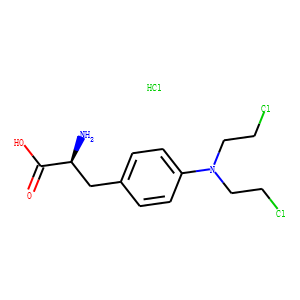| Reference | <span style="font-family:arial,helvetica,sans-serif;"><span style="font-size:12px;">1. J Pediatr Oncol Nurs. 1990 Jan;7(1):35-6. doi: 10.1177/104345429000700110.Melphalan.</span></span>
<div>
<span style="font-family:arial,helvetica,sans-serif;"><span style="font-size:12px;">Betcher DL, Burnham N.</span></span></div>
<div>
</div>
<div>
<span style="font-family:arial,helvetica,sans-serif;"><span style="font-size:12px;">2. Vet Comp Oncol. 2018 Mar;16(1):E123-E129. doi: 10.1111/vco.12356. Epub 2017 Sep 21.</span></span></div>
<div>
<span style="font-family:arial,helvetica,sans-serif;"><span style="font-size:12px;">Oral melphalan for the treatment of relapsed canine lymphoma.Mastromauro ML(1), Suter SE(1), Hauck ML(1), Hess PR(1).</span></span></div>
<div>
</div>
<div>
<span style="font-family:arial,helvetica,sans-serif;"><span style="font-size:12px;">Oral melphalan has been included in multi-agent rescue protocols for canine lymphoma but its activity as a single-agent for this purpose has not been established. Inexpensive cost, ease of administration and tolerability make oral melphalan an attractive candidate for single-agent rescue therapy of canine lymphoma. Retrospective evaluation of 19 cases of relapsed canine lymphoma treated with oral melphalan was performed. Melphalan was primarily administered (n = 16) via a high dose protocol (HDM) with a median dosage of 19.4 mg m-2 . Fifteen dogs (78.9%) were treated concurrently with corticosteroids. Response evaluation was possible for all dogs with a calculated overall clinical benefit (partial response [PR] + stable disease [SD]) of 31.6% (PR 3/19; SD 3/19). Times to progression following melphalan (TTP-M) were 14, 24 and 34 days for responders and 20, 28 and 103 days for dogs experiencing SD. Twelve of 17 dogs evaluable for toxicity experienced an adverse event (AE) with only 3 dogs experiencing a grade III or higher AE. Haematologic toxicity was common (11/17) while gastrointestinal toxicity was rare (1/17). Although treatment resulted in limited clinical benefit and non-durable responses, oral melphalan was well-tolerated and may be a reasonable rescue option in cases where minimal effective agents remain.</span></span></div>
<div>
<br />
<span style="font-family:arial,helvetica,sans-serif;"><span style="font-size:12px;">3.Am J Clin Oncol. 2003 Aug;26(4):429-33. doi: 10.1097/01.COC.0000027269.06091.E9.Melphalan for the treatment of patients with recurrent epithelial ovarian cancer.Davis-Perry S(1), Hernandez E, Houck KL, Shank R.</span></span></div>
<div>
</div>
<div>
<span style="font-family:arial,helvetica,sans-serif;"><span style="font-size:12px;">The purpose of this study was to determine the response to melphalan in patients with recurrent epithelial ovarian cancer after platinum-based therapy. This retrospective observational study analyzed 10 patients with recurrent epithelial ovarian carcinoma treated with melphalan between August 1995 and April 2001. All had received primary platinum-based therapy. Nine of the 10 patients had chemosensitive disease. All but one patient had received one or more second-line therapies prior to melphalan. The median time to recurrence after first-line therapy was 26 months (range, 3-68). Treatment with melphalan resulted in 2 (20%) complete responses and 1 (10%) partial response (response rate, 30%; 95% CI 8%, 65%). The median progression-free interval after initiation of melphalan therapy was 8 months (range, 3-23). The most common side effects were grade I thrombocytopenia (20% of courses) and grade II leukopenia (18% of courses). The use of melphalan as palliative chemotherapy in patients with recurrent ovarian cancer results in response rates similar to those reported with other more expensive agents. Melphalan at the doses reported here has a favorable toxicity profile.</span></span></div>
<div>
</div>
<div>
<span style="font-family:arial,helvetica,sans-serif;"><span style="font-size:12px;">4. Crit Rev Immunol. 2016;36(2):179-191. doi: 10.1615/CritRevImmunol.2016017507. Immunostimulatory Effects of Melphalan and Usefulness in Adoptive Cell Therapy with Antitumor CD4+ T Cells.Kuczma M(1), Ding ZC(1), Zhou G(1).</span></span></div>
<div>
</div>
<div>
<span style="font-family:arial,helvetica,sans-serif;"><span style="font-size:12px;">The alkylating agent melphalan is used in the treatment of hematological malignancies, especially multiple myeloma. In the past, the usefulness of melphalan has been solely attributed to its cytotoxicity on fastgrowing cancerous cells. Although the immunomodulatory effects of melphalan were suggested many years ago, only recently has this aspect of melphalan's activity begun to be elucidated at the molecular level.Emerging evidence indicates that melphalan can foster an immunogenic microenvironment by inducing immunogenic cell death (ICD) as characterized by membrane translocation of endoplasmic reticulum protein calreticulin (CRT) and by release of chromatin-binding protein high mobility group box 1 (HMGB1). In addition, the lympho-depletive effect of melphalan can induce the release of pro-inflammatory cytokines and growth factors, deplete regulatory T cells, and create space to facilitate the expansion of infused tumor-reactive T cells. These features suggest that melphalan can be used as a preparative chemotherapy for adoptive T-cell therapy. This notion is supported by our recent work demonstrating that the combination of melphalan and adoptive transfer of tumor-reactive CD4+ T cells can mediate potent antitumor effects in animal models. This review summarizes the recent advances in understanding and utilizing the immunomodulatory effects of melphalan.</span></span></div>
|

